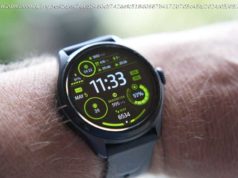Samsung’s Galaxy Fold is the company’s first foldable smartphone, with two screens, six cameras, and a dual-cell battery. The phone may be delayed due to display issues, but that doesn’t stop us from asking — what’s it like to use? We spent some time with the Galaxy Fold, before it was recalled.
I have been spoiled. My time with the Galaxy Fold has come to an end, and while I’ve swapped to the Huawei P30 Pro to test its camera, I can’t stop looking back at Samsung’s first foldable phone. I already miss the satisfying motion of opening and closing it; and I miss the vast 7.3–inch screen, especially for reading books on Amazon’s Kindle app.
I have been spoiled with the Galaxy Fold. There’s no going back. Except, of course, I must — because the Fold’s release has been delayed, and Samsung is recalling all phones shipped so far.
It is difficult to carry on without talking about the elephant in the room. Several journalists encountered issues with the display on their Galaxy Fold review units (some through fault of their own), which has forced Samsung to delay the release of the Fold until May. Samsung has since recalled all Fold units, including review units. I didn’t encounter any problems, and my experience with the Fold has largely been trouble-free.
We’ll just have to wait and see if the month-long delay will help Samsung fix the Fold’s issues, especially since it seems the company has figured out the cause.
“Initial findings from the inspection of reported issues on the display showed that they could be associated with impact on the top and bottom exposed areas of the hinge,” a Samsung spokesperson told Digital Trends. “There was also an instance where substances found inside the device affected the display performance. We will take measures to strengthen the display protection.”
In truth, I was never going to recommend the Galaxy Fold. It’s far too expensive for what it offers. Being a first-gen product, it’s also likely you will run into issues down the road. Most people don’t want to be beta testers when they drop close to $2,000 for a product, and rightly so. The only people I think who should entertain the idea of owning a Fold are those who live on the bleeding edge of technology and have money to blow.
If the Fold’s problems are fixed come May, then great. It’s a good step toward the future of foldable smartphones, and it means you should keep your eyes on Samsung’s second-generation foldable phone, as well as what’s coming from the competition. But until manufacturers can bring foldable phone prices down, I don’t think most people should drop their hard-earned money on these products just yet.
Now, onto what you want to hear about. Using the Galaxy Fold is quite unlike anything else. There are two screens: The first is what you see when you hold the phone folded up. It’s a small, 4.6-inch Super AMOLED HD screen (1,680 x 720), and it’s surrounded by thick bezels that make it look like its from 2008. Open the Fold up like a book, however, and you’re greeted to a sprawling 7.3-inch Dynamic AMOLED screen with a QXGA+ resolution (2,152 x 1536).
The 7.3-inch screen steals the show. Samsung calls it an Infinity Flex display, made from bonded layers of polymer material rather than glass. It doesn’t feel as smooth as on glass, but it’s close. Opening it is easy once you get a good grip on the edges, but snapping it shut is so much more satisfying — like hanging up a call on a flip phone.
When folded, the Fold more or less takes up the same length as the Galaxy S10 Plus. The thickness, however, is what’s noticeable as it’s the equivalent of two phones stacked on top of each other. I stopped thinking about thickness after my first few days of using it, when I found the Fold fit in all my pant pockets without fail. This will be a problem for those with small pockets, of course.
You’ll also notice how narrow the phone is when it’s closed. It’s easy to wrap your hand around, but of course this is a different story unfolded. When it’s open like a book, the Fold is lightweight enough to manage, but any interaction will require both hands. There’s too much screen to be able to reach all parts of it one handed.
The hinge hides away when the Fold is opened up, which is neat. It’s on the other edge that you’ll find the power button and volume rocker, as well as a fingerprint scanner not unlike the one on the Galaxy S10e. The scanner doubles as the Bixby button when pressed, and will call up Samsung’s virtual assistant.
There’s no fancy in-display fingerprint sensor like on the Galaxy S10 or S10 Plus, which may be a good thing considering the issues many are having with its accuracy. There is a basic face unlock you can use to unlock the screen as an alternative, but it’s not secure like Apple’s Face ID. This may come as a shock, but there’s no headphone jack — it’s one of the first flagship phones from Samsung to omit the port — so you’ll have to rely on wireless earbuds or headphones (you get a pair of Galaxy Buds in the box). The phone is not water resistant, either.
When I first opened the Fold, both sides surrounding the hinge remained as flat as a pancake. After a week of using it, the phone no longer sits truly flat. The edges slightly stick up, especially when held in the hand. The Fold itself doesn’t feel as stiff as it did right out of the box. I can now feel and hear sounds of the parts shifting and rubbing each other while holding the Fold unfolded. It does make me wonder how put together the Fold will feel after a year of use.
Yes, it does feel like a brick — like a certain Nokia phone of old — but it also feels like a drop will ruin the hinge and take the phone out of commission. If it’s any comfort, a case is included in the box, one that’s made up of a Kevlar-like material. It feels soft, and putting it on means you won’t have to deal with ugly fingerprints and smudges on the glass back and front.
The 7.






